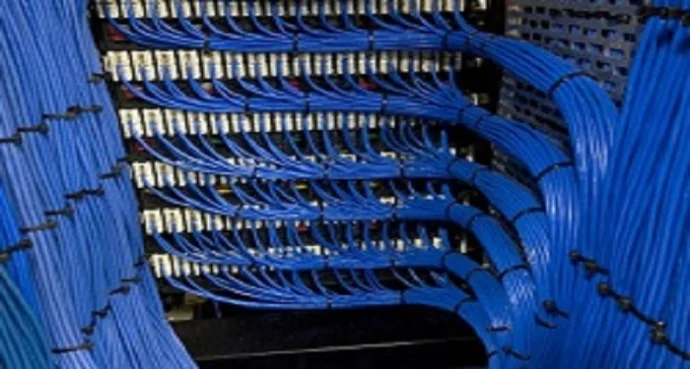Why Structured Cabling Suits Datacentre Environments
In the IT industry point-to-point network cabling has been the de-facto standard for almost 25 years when connecting control networks or interconnected devices. As datacentres expand their processing power and capacity through virtualisation and more powerful servers, a higher speed, higher density and larger scale network cabling approach is required and the best alternative is known as ‘structured cabling’.
Point-to-Point Cabling Systems
Direct connections from servers to switches, storage devices and other network connections can use what is known as a ‘Point-to-Point’ arrangement. This can be costly and lead to several problems in a complex network such as misconnection and disconnection errors without a clearly labelled and identified cabling system.
Structured Cabling Networks
The structured approach is more suited to a larger network deployment and is more of a planned and complete cabling system for an entire facility that can serve a wide range of IT, telecoms, security, video and environment monitoring applications. Such a cabling system can include up to six or more subsystems including:
- Entrance: connecting the telephone system to the point of entry carrier network.
- Server Rooms: housing the IT equipment and providing a central network connection point.
- Backbone: connecting IT related rooms on different floors in a building.
- Telecoms: connection points from the backbone to the horizontal network(s).
- Horizontal: connection from the telecoms and server rooms to access points in the building through ceiling and raised access floor voids and channels.
- General Office Areas: connecting end applications to the access points on the horizontal cabling system.
Structured data cabling can provide the functionality and scalability required throughout the datacentre facility including within the white space itself. Here Top of Rack (ToR) and End of Row (EoR) cabling and mounting options can enhance a structured cabling system approach. Whilst ToR and EoR can themselves be more reliant on point-to-point cabling, inside the server cabinets where Fibre or Twinax copper assemblies or patch panels and cord may be used to connect network and storage devices to the servers within the cabinets.
Relevant Standards
When it comes to any design and installation cabling project, the relevant standards for the building network should be complied with in terms of communications and control cabling whether using fibre or twisted pairs, CAT5 or CAT6 network and telecoms cabling. Around the world there are different cabling and network standards bodies and these can include:
- ANSI – American National Standards Institute
- EIA – Electronic Industries Alliance
- TIA – Telecommunications Industry Association
- ISO – International Organization for Standardization
- IEC – International Electrotechnical Commission
- CENELEC – European Committee for Electrotechnical Standardization
The ISO/IEC, CENELEC and TIA standards are considered to be international ones. In Europe CENELEC may be more accepted. In the USA, TIA and ANSI are the recognised standards.
Cable Type Considerations
When it comes to both backbone and horizontal cabling there are two principle cabling options: Fibre or Copper cable.
Fibre or Optical Fibre is the cabling system of choice for backbone networks as it can reach longer distances than copper cables and support higher bandwidths. Optical fibre cabling also offers lower convergence times and therefore higher resilience than copper.
Copper is the cabling system of choice for horizontal and office work are networks as it is more compatible generally with standard port switches and connection ports.
Whichever type of cabling material is chosen for your structured cabling network, consideration should be given to scale and future-proofing the installation. Most networks require upgrade at some point and migration to other network technologies. The right choice of cable (Fibre or Copper) can impact future changes and network choices.
Is Structure Cabling Right For You?
The structured cabling approach may be more expensive than point-to-point as it requires as the name suggests, a more ‘structured’ approach and potentially the Ethernet installation of more expensive cable and associated hardware. It can be interesting to contrast the approaches.
In terms of the installation itself, structured cabling can allow multiple connectivity points but point-to-point cabling can be more suited where and easy and fast connection point is required. Point-to-point cabling is also more suitable where tight bends or cable flexing is required to route the cable and also where a patch panel cannot be installed.
For maintainability, a structured cabling network offers more advantages. The cabling network can offer the potential for multiple changes compare to point-to-point is less flexible. Structured cabling using optical fibre can accommodate slack cable where as this is less desirable for a copper based point-to-point cabling network.
When it comes to future-proof designs and adaptability, the structured cabling approach will always be the preferred choice. It is just too impractical with a point-to-point network to have spare cable laying around, whether protected or unprotected.
Whilst the final choice may lay with the overall design and specification requirements. A structure network cabling approach using OM3 or OM4 may well provide longer warranties and provide the necessary bandwidth to cope with future network developments.
At Server Environments we can design and build any network cabling system from scratch or as an addition to an existing system. Our services include a complete project management service including installation, testing and certification whether you want to adopt a point-to-point or structured cabling network. Several of our clients run with point-to-point cabling networks out of necessity, based on a single server cabinet. Our designs generally enable this type of arrangement to grow and expand into a complete structure cabling network as their business and organisations grow.

























